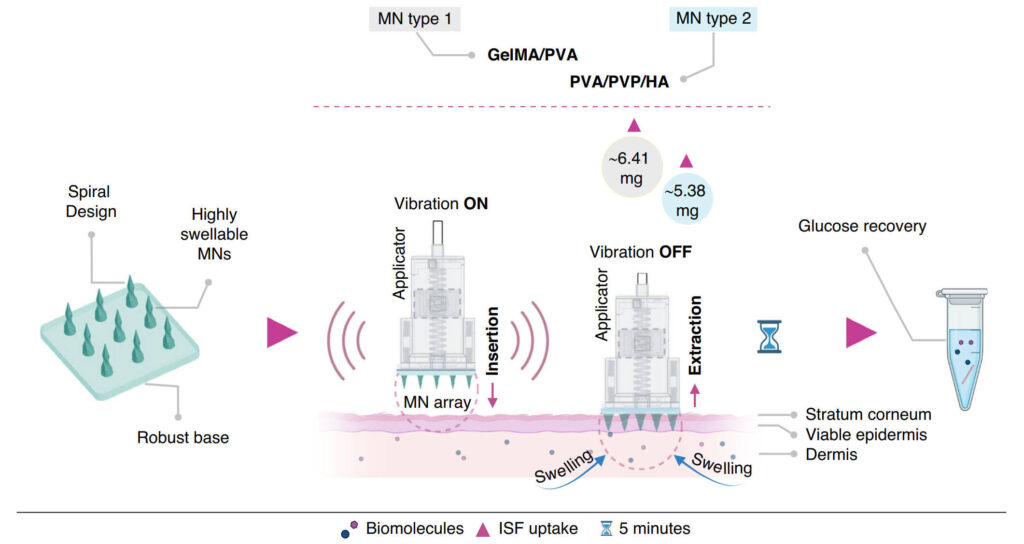Scientists have created a new way to quickly and minimally invasively detect glucose using microneedles. These swellable hydrogel microneedles extract substantial amounts of skin fluid in just five minutes, a less invasive alternative to the finger-prick blood tests.
The extraction of interstitial fluid (ISF) for diagnostic purposes has long been a challenging process. Traditional methods, such as suction blister and sonophoresis, are not only time-consuming but also often result in significant disruption to the skin’s outermost layer, the stratum corneum, causing local trauma.
Microneedles (MNs) have emerged as a promising alternative, offering a less invasive way to access ISF. However, current MN technologies are limited by their low extraction volumes and prolonged extraction times, typically requiring 10–15 minutes to obtain only small amounts of ISF. Given these limitations, there is a critical need for research to develop faster and more efficient ISF extraction methods.
In a study published in Microsystems & Nanoengineering, researchers from the University of Southern Queensland, Australia, present a novel approach to ISF extraction using micro-vibration assisted dual-layer spiral microneedles.
The study details the development and testing of these microneedles, which are designed to rapidly and efficiently extract ISF for biomarker sensing.
The study introduces two innovative types of spiral-shaped, swellable microneedle arrays designed for rapid interstitial fluid (ISF) extraction.
The first array is composed of gelatin methacryloyl (GelMA) and PVA, while the second incorporates a combination of polyvinyl alcohol (PVA), polyvinylpyrrolidone (PVP), and hyaluronic acid (HA). These microneedles demonstrated impressive swelling ratios of 560 ± 79.6% and 370 ± 34.1% in artificial ISF within just 10 minutes, respectively.
A key innovation of this research is the development of a custom-designed Arduino-based applicator that vibrates at frequencies between 50–100 Hz. This micro-vibration technology significantly enhances the skin penetration efficiency of the microneedles, allowing for more effective uptake of ISF.
In ex vivo tests on porcine ear skin, the GelMA/PVA microneedles were able to rapidly uptake 6.41 ± 1.01 mg of ISF in just five minutes, while the PVA/PVP/HA microneedles extracted 5.38 ± 0.77 mg within the same timeframe.
To validate the microneedles’ ability to recover glucose as a target biomarker, a mild heating procedure was used, followed by glucose concentration determination using a D-glucose content assay kit. The results showed that the microneedles could efficiently extract ISF and detect glucose, suggesting their potential for rapid and minimally invasive biomarker sensing.
This research not only addresses the limitations of current ISF extraction methods but also opens new avenues for the development of point-of-care diagnostics and real-time health monitoring devices.
According to Dr. Zahra Faraji Rad, the lead researcher, “This study represents a significant advancement in the field of minimally invasive diagnostics. The combination of novel microneedle design and micro-vibration technology has the potential to simplify the way we extract and analyze biomarkers, making the process faster, more efficient, and less invasive.”
The development of these microneedles has broad implications for point-of-care diagnostics for biomarker detection. They offer a viable alternative to traditional blood sampling, particularly in resource-limited settings or for patients requiring frequent monitoring.
The rapid extraction of ISF and efficient glucose detection capabilities of these microneedles suggest their potential for use in the management of chronic conditions like diabetes, where frequent finger pricks are typically required to draw blood for glucose detection.
Provided by
Aerospace Information Research Institute, Chinese Academy of Sciences


